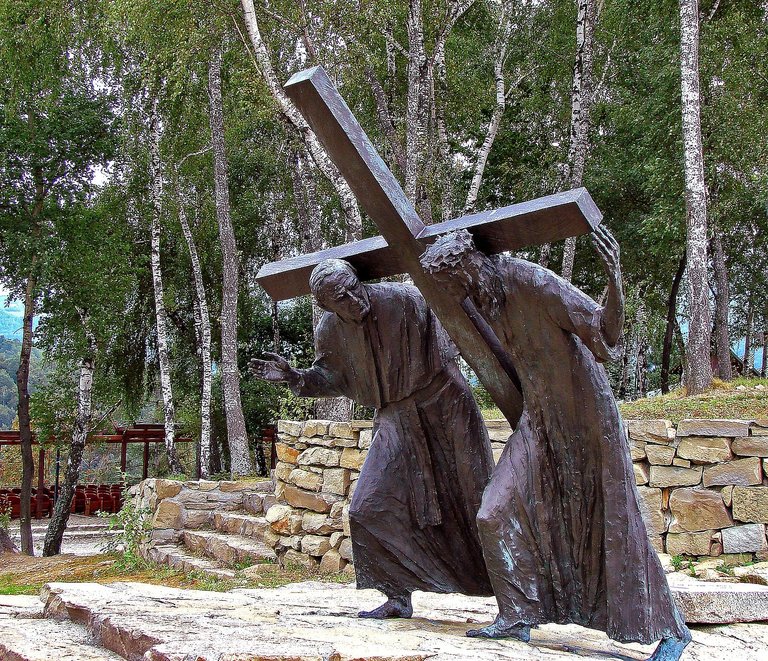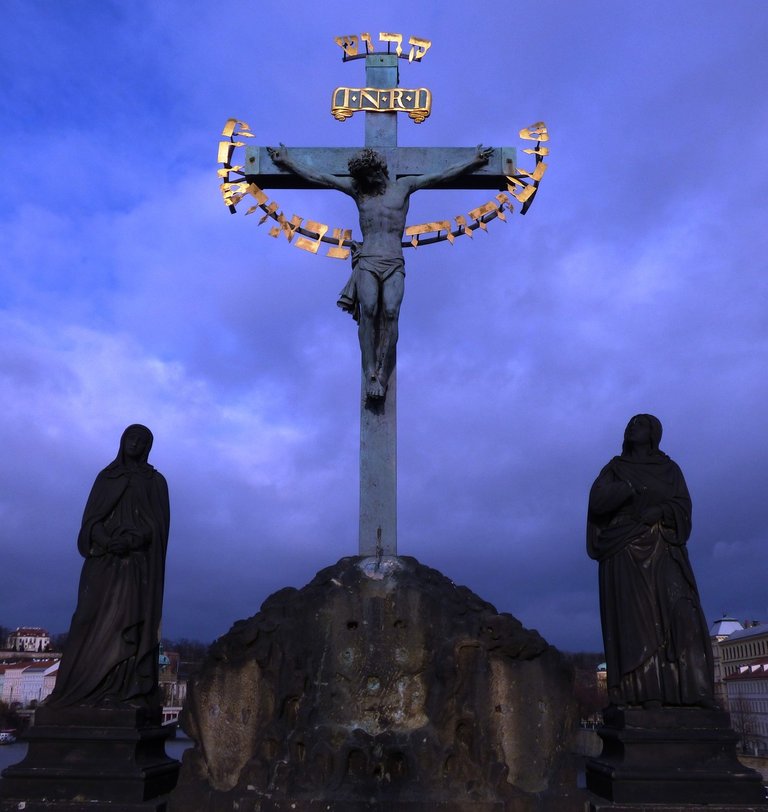Poema: El Vía Crucis || (ESP-ENG)
El Vía Crucis es el camino hacia la cruz, que representa el camino recorrido por el Hijo de Dios durante los momentos difíciles que enfrentó desde que fue arrestado y entregado a morir por los pecados de la humanidad. El Vía Crucis nos muestra los momentos difíciles desde la muerte de Cristo hasta la resurrección.
Durante la Semana Santa la fe cristiana se revela y recuerda todo lo que representó y significa para la humanidad la vida, muerte y resurrección de Jesucristo.
The Via Crucis is the path to the cross, which represents the journey taken by the Son of God during the difficult moments he faced since he was arrested and handed over to die for the sins of humanity. The Via Crucis shows us the difficult moments from the death of Christ to the resurrection.
During Holy Week, the Christian faith is revealed and brings to mind everything that the life, death and resurrection of Jesus Christ represented and means for humanity.

Imagen source

El Vía Crucis
Camino de la cruz
Espinas y huellas de dolor.
Rostro de sufrimiento y heridas horrendas.
Camino de terror con sombra de muerte
y oscura esperanza del olvido.
El peso de la madera sobre su hombro
y heridas abiertas en su cuerpo.
La fuerza se pierde con el peso de la cruz.
Allí el hombre en condenación
y amparado en la sentencia de muerte segura.
La multitud lo siguió
y la pesada cruz lo derriba al suelo.
Cansado y exhausto miró a la multitud.
Su inocencia conllevaba la culpa de los demás.
Corona de espinas en la cabeza
y gotas de sangre en su rostro.
El vía crucis fue horrendo.
No importaba el peso que llevaba
Le importaba el amor por aquellos que sufría.
El Vía Crucis de su sufrimiento
y el dolor que lo desgarró.
En su corazón un desierto de esperanza
y la soledad que le gritaba.
Sufrió y no abandonó el sufrimiento.
La culpa de la humanidad fue el peso de la cruz.
Le encantaba sufrir tanto
que porque sufrió nos amó.
Fue levantado en la cruz,
en aquel calvario entre dos criminales
y traspasado con clavos en sus manos,
soportó el dolor y la angustia del abandono.
Sus pies también fueron clavados
y su costado traspasado por la espada,
su sangre era el propiciatorio del sacrificio.
Levantado en la cruz
y la corona de espinas en su cabeza,
no renunció al castigo ni a la muerte,
él sabía por quién sufrió
y sabía que amaba a la humanidad pecadora.
Renunció a su espíritu y expiró.
No dudó en sufrir y morir.
Sus brazos abiertos al amor en la cruz,
quedaron su quebrantamiento y dolor.
Al tercer día despertó del terror
y resucitó para una esperanza mayor.
Murió y resucitó por amor a la creación de Dios.
El Vía Crucis de la Semana Santa
El Calvario recordado durante siglos
El amor de Dios por la humanidad
y el sello de la salvación en su Hijo amado.

Imagen source
The Via Crucis
way of the cross
Thorns and traces of pain.
Face of suffering and horrendous wounds.
Path of terror with shadow of death
and dark hope of oblivion.
The weight of the wood on your shoulder
and open wounds on his body.
Strength is lost with the weight of the cross.
There the man in damnation
and protected by the sentence of certain death.
The crowd followed him
and the heavy cross knocks him to the ground.
Tired and exhausted he looked at the crowd.
His innocence carried the guilt of others.
crown of thorns on the head
and drops of blood on his face.
The via crucis was horrendous.
It didn't matter how much weight he carried
He cared about love for those he suffered.
The Via Crucis of his suffering
and the pain that tore him apart.
In his heart a desert of hope
and the loneliness that screamed at him.
He suffered and did not abandon suffering.
The guilt of humanity was the weight of the cross.
He loved to suffer so much
that because he suffered he loved us.
He was lifted up on the cross,
in that ordeal between two criminals
and pierced with nails in his hands,
he endured the pain and anguish of abandonment.
His feet were also nailed
and his side pierced by the sword,
His blood was the mercy seat of the sacrifice.
Lifted up on the cross
and the crown of thorns on his head,
He did not renounce punishment or death,
he knew who he suffered for
and he knew that he loved sinful humanity.
He renounced the spirit of him and expired.
He did not hesitate to suffer and die.
His arms open to love on the cross,
His brokenness and pain remained.
On the third day he woke up from terror
and he rose again to a greater hope.
He died and rose again for love of God's creation.
The Via Crucis of Holy Week
Calvary remembered for centuries
God's love for humanity
and the seal of salvation in his beloved Son.

Imagen source

You've received an upvote from the Blockchain Poets account. Thank you for submitting your poem to our community!